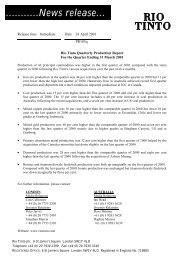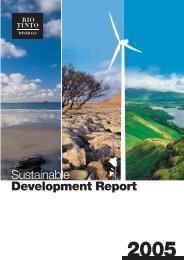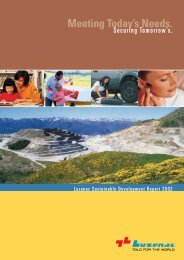Corporate brochure - Diverse places (PDF 2.36 MB) - Rio Tinto
Corporate brochure - Diverse places (PDF 2.36 MB) - Rio Tinto
Corporate brochure - Diverse places (PDF 2.36 MB) - Rio Tinto
Create successful ePaper yourself
Turn your PDF publications into a flip-book with our unique Google optimized e-Paper software.
<strong>Diverse</strong> <strong>places</strong><br />
A global journey to many of <strong>Rio</strong> <strong>Tinto</strong>’s<br />
operating sites near and far.
01 Welcome to <strong>Rio</strong> <strong>Tinto</strong><br />
02 The origins of <strong>Rio</strong> <strong>Tinto</strong><br />
02 Our global reach<br />
04 Major Group operations<br />
06 North America<br />
08 Antelope<br />
12 Boron<br />
16 Diavik<br />
20 Bingham Canyon<br />
24 Australia<br />
26 Pilbara Iron<br />
30 Hail Creek<br />
34 Dampier<br />
38 Gladstone<br />
42 South America<br />
44 Corumbá<br />
48 Africa<br />
50 Rössing<br />
54 Madagascar<br />
58 Europe<br />
60 Kleinfeistritz<br />
64 <strong>Diverse</strong> contributions
<strong>Rio</strong> <strong>Tinto</strong> invests in large, long life<br />
mines, such as Cortez in Nevada, US.<br />
Welcome to <strong>Rio</strong> <strong>Tinto</strong><br />
<strong>Rio</strong> <strong>Tinto</strong> is a leading international mining<br />
group, combining <strong>Rio</strong> <strong>Tinto</strong> plc, a London<br />
listed public company headquartered in<br />
the UK, and <strong>Rio</strong> <strong>Tinto</strong> Limited, which is<br />
listed on the Australian Stock Exchange,<br />
with executive offices in Melbourne.<br />
The companies are joined in a “dual listed companies” (DLC)<br />
structure as a single economic entity, called the <strong>Rio</strong> <strong>Tinto</strong> Group.<br />
The DLC <strong>places</strong> shareholders of both companies in substantially<br />
the same position as if they held shares in a single enterprise<br />
owning all of the assets of both companies. Nevertheless, both<br />
companies remain legal entities with separate share listings<br />
and registers.<br />
<strong>Rio</strong> <strong>Tinto</strong>’s fundamental objective is to maximise the overall long<br />
term financial return to its shareholders by operating responsibly<br />
and sustainably in areas of proven expertise where the Group has<br />
competitive advantage. Its strategy is to maximise net present<br />
value (NPV) by investing in large, long life, cost competitive mines.<br />
Investments are driven by the quality of opportunity, not choice of<br />
commodity or country.<br />
<strong>Rio</strong> <strong>Tinto</strong>’s mining interests produce a broad range of products<br />
in diverse <strong>places</strong> around the world. The Group consists of wholly<br />
and partly owned subsidiaries, jointly controlled assets, jointly<br />
controlled entities and associated companies.<br />
Wherever <strong>Rio</strong> <strong>Tinto</strong> operates, the health and safety of employees<br />
is the first priority. The Group seeks to contribute to sustainable<br />
development. It works as closely as possible with host countries<br />
and communities, respecting their laws and customs, and<br />
minimising the effects of its activities on the environment.<br />
01
02<br />
The origins of <strong>Rio</strong> <strong>Tinto</strong><br />
The <strong>Rio</strong> <strong>Tinto</strong> Company was formed by investors in 1873 to mine<br />
ancient copper workings at <strong>Rio</strong> <strong>Tinto</strong> in southern Spain. The<br />
Consolidated Zinc Corporation was incorporated in 1905, initially<br />
to treat zinc bearing mine waste at Broken Hill, New South Wales,<br />
Australia.<br />
The RTZ Corporation (formerly The <strong>Rio</strong> <strong>Tinto</strong>-Zinc Corporation)<br />
was formed in 1962 by the merger of The <strong>Rio</strong> <strong>Tinto</strong> Company<br />
and The Consolidated Zinc Corporation. CRA Limited (formerly<br />
Conzinc <strong>Rio</strong>tinto of Australia Limited) was formed at the same time<br />
by a merger of the Australian interests of The Consolidated Zinc<br />
Corporation and The <strong>Rio</strong> <strong>Tinto</strong> Company. Between 1962 and 1995,<br />
RTZ and CRA discovered important mineral deposits, developed<br />
major mining projects and also grew through acquisition.<br />
RTZ and CRA were unified in December 1995 through a dual listed<br />
companies (DLC) merger. In June 1997, The RTZ Corporation<br />
and CRA Limited changed their respective names to <strong>Rio</strong> <strong>Tinto</strong> plc<br />
and <strong>Rio</strong> <strong>Tinto</strong> Limited, together known as the <strong>Rio</strong> <strong>Tinto</strong> Group.<br />
Since the 1995 DLC merger, the Group has continued to invest in<br />
developments and acquisitions in keeping with its strategy of<br />
maximising value to shareholders.<br />
Our global reach<br />
The <strong>Rio</strong> <strong>Tinto</strong> Group comprises 30 businesses that control<br />
80 operations in 20 countries, employing more than 30,000 people.<br />
Taking into account mineral exploration and other business activities,<br />
<strong>Rio</strong> <strong>Tinto</strong> has a presence in about 40 countries.<br />
Our businesses include open pit and underground mines, mills,<br />
refineries and smelters as well as a number of research and service<br />
facilities around the globe.<br />
Visit a representative sampling of our diverse operations in the<br />
following pages.
1873<br />
The <strong>Rio</strong> <strong>Tinto</strong> Company<br />
(UK)<br />
<strong>Rio</strong> <strong>Tinto</strong> plc<br />
(UK)<br />
1962<br />
Merger<br />
The <strong>Rio</strong> <strong>Tinto</strong>-Zinc Corporation<br />
renamed The RTZ Corporation<br />
(UK)<br />
1905<br />
The Consolidated Zinc Corporation<br />
(UK)<br />
1995<br />
DLC merger<br />
<strong>Rio</strong> <strong>Tinto</strong> Group<br />
Conzinc <strong>Rio</strong>tinto of Australia<br />
renamed CRA<br />
(Australia)<br />
<strong>Rio</strong> <strong>Tinto</strong> Limited<br />
(Australia)<br />
03
04<br />
Major Group<br />
operations<br />
Iron ore and Iron<br />
Operating sites<br />
01 Corumbá<br />
02 Hamersley Iron mines:<br />
Brockman<br />
Marandoo<br />
Mt Tom Price<br />
Nammuldi<br />
Paraburdoo<br />
Yandicoogina<br />
Channar (60%)<br />
Eastern Range (54%)<br />
03 Robe River mines: (53%)<br />
West Angelas<br />
Pannawonica<br />
04 HIsmelt ® (60%)<br />
05 Iron Ore Company of Canada (59%)<br />
Projects<br />
06 IOC Pellet Plant (59%)<br />
07 Simandou (95%)<br />
08 Orissa (51%)<br />
Energy<br />
Operating sites<br />
09 Antelope<br />
10 Bengalla (30%)<br />
11 Blair Athol (71%)<br />
12 Colowyo (20%)<br />
13 Cordero Rojo<br />
14 Decker (50%)<br />
15 Spring Creek<br />
16 Hail Creek (82%)<br />
17 Hunter Valley Operations (76%)<br />
18 Jacobs Ranch<br />
19 Kestrel (80%)<br />
20 Mt Thorley Operations (61%)<br />
21 Tarong<br />
22 Warkworth (42%)<br />
23 ERA (68%)<br />
24 Rössing (69%)<br />
Projects<br />
25 Clermont (50%)<br />
26 Mt Pleasant (76%)<br />
Industrial minerals<br />
Operating sites<br />
27 Boron<br />
28 Coudekerque Plant<br />
29 Tincalayu<br />
30 Wilmington Plant<br />
31 Dampier (65%)<br />
32 Lake MacLeod (65%)<br />
33 Port Hedland (65%)<br />
34 Ludlow<br />
35 Talc de Luzenac<br />
36 Yellowstone<br />
37 Three Springs<br />
38 QIT-Fer et Titane Lac Allard<br />
39 QIT-Fer et Titane Sorel Plant<br />
40 Richards Bay Minerals (50%)<br />
Projects<br />
41 <strong>Rio</strong> Colorado Potash<br />
42 QIT Madagascar Minerals (80%)<br />
Aluminium<br />
Operating sites<br />
43 Anglesey Aluminium (51%)<br />
44 Bell Bay<br />
45 Boyne Island (59%)<br />
46 Yarwun alumina refinery<br />
47 Gladstone Power Station (42%)<br />
48 Queensland Alumina (39%)<br />
49 Tiwai Point (79%)<br />
50 Weipa<br />
Copper<br />
Operating sites<br />
51 Bougainville (not operating) (54%)<br />
52 Cortez/Pipeline (40%)<br />
53 Escondida (30%)<br />
54 Grasberg joint venture (40%)<br />
55 Kennecott Utah Copper<br />
56 Northparkes (80%)<br />
57 Palabora (58%)<br />
58 Rawhide (51%)<br />
59 Greens Creek (70%)<br />
Projects<br />
60 Resolution (55%)<br />
61 Eagle<br />
62 La Granja<br />
63 Oyu Tolgoi (10%)<br />
Diamonds<br />
Operating sites<br />
64 Argyle<br />
65 Diavik (60%)<br />
66 Murowa (78%)
Greens Creek 59<br />
Yellowstone 36<br />
Kennecott Utah Copper 55<br />
Cortez/Pipeline 52<br />
Rawhide 58<br />
Wilmington Plant 30<br />
Diavik 65<br />
12 Colowyo<br />
60 Resolution<br />
27 Boron<br />
Iron Ore Company of Canada 05<br />
IOC Pellet Plant 06<br />
QIT-Fer et Titane Sorel Plant 39<br />
14 Decker<br />
15 Spring Creek<br />
61 Eagle<br />
09 Antelope<br />
13 Cordero Rojo<br />
18 Jacobs Ranch<br />
La Granja 62<br />
Escondida 53<br />
<strong>Rio</strong> Colorado Potash 41<br />
34 Ludlow<br />
29 Tincalayu<br />
38 QIT-Fer et Titane Lac Allard<br />
01 Corumbá<br />
Anglesey Aluminium 43<br />
Coudekerque Plant 28<br />
Talc de Luzenac 35<br />
Simandou 07<br />
Rössing 24<br />
66 Murowa<br />
57 Palabora<br />
40 Richards Bay Minerals<br />
42 QIT Madagascar Minerals<br />
08 Orissa<br />
63 Oyu Tolgoi<br />
Port Hedland 33<br />
Dampier 31<br />
Lake MacLeod 32<br />
Three Springs 37<br />
HIsmelt ® 04<br />
Grasberg joint venture 54<br />
Argyle 64<br />
ERA 23<br />
Weipa 50<br />
02 Hamersley Iron mines<br />
03 Robe River mines<br />
Bougainville 51<br />
44 Bell Bay<br />
21 Tarong<br />
56 Northparkes 49 Tiwai Point<br />
11 Blair Athol<br />
16 Hail Creek<br />
19 Kestrel<br />
25 Clermont<br />
45 Boyne Island<br />
46 Yarwun alumina refinery<br />
47 Gladstone power station<br />
48 Queensland Alumina<br />
10 Bengalla<br />
17 Hunter Valley Operations<br />
20 Mt Thorley Operations<br />
22 Warkworth<br />
26 Mt Pleasant
<strong>Rio</strong> <strong>Tinto</strong> concentrates on the development of first class orebodies<br />
into large, long life and efficient mines, capable of sustaining<br />
competitive advantage through fluctuations in the business cycle.<br />
Investments are driven by the quality of each opportunity rather<br />
than by a predetermined choice of commodity.<br />
The Group’s activities span the world but are strongly represented<br />
in Australia and North America with significant businesses in South<br />
America, Asia, Europe and southern Africa. Our businesses include<br />
open pit and underground mines, mills, refineries and smelters as<br />
well as a number of research and service facilities around the globe.<br />
Major products are aluminium, copper, diamonds, energy products<br />
(coal and uranium), gold, industrial minerals (borax, talc, titanium<br />
dioxide and salt), and iron ore.<br />
05
06<br />
North America<br />
A blue sky view over the Salt Lake<br />
Valley on the eastern side of Bingham<br />
Canyon Mine.
Antelope<br />
Main image: A blast of explosives<br />
opens access to coal resources.<br />
1 Heavy duty trains take coal<br />
to power stations.<br />
2 Trains are loaded from coal<br />
storage silos.<br />
3 Lockout tags for safety.<br />
In Wyoming’s coal country, <strong>Rio</strong> <strong>Tinto</strong> Energy America (RTEA) is<br />
based in Gillette, the “Energy Capital of the US” and manages<br />
five open cut coal mines, including Antelope.<br />
The great northern plains of Wyoming form the Powder River<br />
Basin, edging into Montana to the north and South Dakota to<br />
the north east. This is the land of the legendary American west,<br />
of cowboys and Indians, cattle rustlers and herds of buffalo.<br />
Overlooked to the west by the mountains of the continental divide,<br />
the great plains form a limitless landscape covered with short<br />
prairie grass.<br />
The coal mines form a chain south of Gillette, following outcropping<br />
coal seams believed to have formed from the organic detritus of<br />
a vast inland sea 500 million years ago. The US has an estimated<br />
245 billion tonnes of recoverable coal in existing mines, about twice<br />
as much energy in coal as Saudi Arabia has in oil. This could last<br />
a few centuries or more – and nearly half of it is in the Powder River<br />
Basin. RTEA is the largest coal producer and accounts for about<br />
a third of production.<br />
2<br />
3<br />
1<br />
09
10<br />
Antelope<br />
1 2<br />
At Antelope the coal seam is about 10 metres thick, overlain by<br />
about 33 metres of earth. Mining is a simple process, using the<br />
largest land based equipment available. A “dragline” the size of<br />
a three storey building, with an arm nearly as long as a football<br />
pitch, scrapes soil and rock away to expose the coal seam. Coal<br />
is blasted, loaded, hauled in 240 ton trucks to a crusher station,<br />
then conveyed to silos. It is a continuous process of “just in time”<br />
delivery. The silos are filled from the mine as fast as the coal<br />
is carried away by the 140 car trains. They snake through the<br />
loading stations beneath the silos to pick up coal for distant<br />
power stations. The loadouts ship six or seven trains a day each<br />
carrying 15,000 tons of coal. For millions of consumers, the light<br />
that comes on with a flick of a switch starts here.
3<br />
1 A “walking” dragline removes rock<br />
and earth to expose the coal seam.<br />
2 Blasting along long horizontal seams<br />
of pure coal which occur near the<br />
surface of the land.<br />
3 Trains of 140 cars operate on<br />
dedicated railways.<br />
11
12<br />
Boron<br />
Main image: <strong>Rio</strong> <strong>Tinto</strong> Minerals and<br />
its predecessors have been extracting<br />
multi-purpose borates from this site in<br />
California for more than 130 years.<br />
1 Aerial view of <strong>Rio</strong> <strong>Tinto</strong> Minerals’<br />
Boron Operations mine and refineries<br />
in the Mojave Desert, California, US.<br />
2 Famous 20 mule teams haul borates<br />
out of Death Valley from the company’s<br />
original borate mine.<br />
One thing flourishes in Death Valley and that’s borates. <strong>Rio</strong> <strong>Tinto</strong><br />
Minerals operates California’s largest open pit mine at Boron<br />
in the Mojave Desert. This is one of the richest borate deposits<br />
on the planet. Borates are a generic term for boron compounds<br />
that contain oxygen, minerals essential to life and modern living<br />
and an ingredient in hundreds of products. The deposit has been<br />
mined for nearly 80 years and is estimated to have enough<br />
resources for another 75 years of production. <strong>Rio</strong> <strong>Tinto</strong> supplies<br />
nearly half the world’s demand for refined borates.<br />
Borate deposits were discovered in Death Valley in 1872. Borax<br />
used to haul ore out of the remote desert on high sided wagons<br />
drawn by mule teams. The loaded wagons carrying ten tonnes –<br />
about one tenth the capacity of a modern rail car – had to be<br />
hauled 265 kilometres up and out of Death Valley, over the steep<br />
Panamint Mountains and across the desert to the nearest railway<br />
junction at Mojave. The 20 day round trip started 58 metres below<br />
sea level and climbed to an elevation of 600 metres. The task<br />
was achieved by hitching two ten mule teams together to form<br />
a 30 metre long, 20 mule team. The 20 Mule Team Borax product<br />
brand lives on as a symbol of the company’s commitment to<br />
innovation.<br />
1<br />
2
14<br />
1<br />
1 <strong>Rio</strong> <strong>Tinto</strong> Minerals’ primary borates<br />
refining operation in California’s<br />
Mojave Desert.
Boron<br />
2 Joshua Trees grow wild in the Mojave<br />
Desert which surrounds the mine.<br />
3 A view over Boron’s conveyor line<br />
and secondary crusher.<br />
The Boron mine open pit measures 1.6 kilometres wide,<br />
2.4 kilometres long and up to 210 metres deep. More than<br />
80 different types of mineral are found of which the four main<br />
types of borates are tincal, kernite, ulexite and colemanite.<br />
The ore is mined at a rate of about three million tonnes per year<br />
to produce about one million tonnes of borax, boric acid<br />
and anhydrous products. A fleet of nearly 800 rail cars, the<br />
modern version of the 20 mule teams, transport borates to<br />
North American customers and the central shipping facility<br />
at the Port of Los Angeles.<br />
2<br />
3<br />
15
Diavik<br />
(<strong>Rio</strong> <strong>Tinto</strong> 60 per cent)<br />
Main image: Diavik diamond mine in<br />
Canada’s Northwest Territories.<br />
Photograph: © Jiri Hermann<br />
1 Caribou on the Canadian tundra near<br />
the Diavik mine.<br />
North western Canada above the 60th parallel is a patchwork<br />
quilt of lakes big and small that dot the land in such profusion it is<br />
not clear whether this is land interspersed with lakes or a body of<br />
water broken by islands. Beneath one of these lakes, Lac de Gras,<br />
300 kilometres north east of Yellowknife the capital of the<br />
Northwest Territories, lies a store of diamonds in kimberlite pipes.<br />
These are carrot shaped roots of ancient volcanoes that brought<br />
the gems from deep within the earth.<br />
Diamond mining is a relatively simple operation, requiring loading,<br />
hauling and dumping of gravels, and processing to extract the<br />
valuable stones. But how to mine a lake bed?<br />
Diavik’s kimberlite pipes are located just off shore, so water<br />
diversion structures, called dikes, were built to temporarily hold<br />
back the waters to allow mining. The A154 rockfill dike contains<br />
four million tonnes of rubble. When the dike was in place, fish in the<br />
enclosed water were caught and released outside, and the water<br />
was pumped out. When mining is completed in about 20 years’<br />
time, the dikes will be breached and the excavations flooded.<br />
1<br />
17
18<br />
Diavik<br />
(<strong>Rio</strong> <strong>Tinto</strong> 60 per cent)<br />
1<br />
The first dike, the 3.9 kilometre A154 dike, was made watertight in<br />
July 2002. It was pumped dry three months later. The dike averages<br />
10 metres high and is 28 metres at its deepest. Construction of<br />
a second dike started in 2005 for completion by the end of 2006<br />
to permit mining of the A418 orebody from 2008. Diavik produces<br />
about eight million carats of high quality gemstones a year.<br />
The remote site is supplied by air and by freight trucks using an<br />
ice road made across the frozen lakes during the coldest part of<br />
the winter. About a third of the workforce is made up of indigenous<br />
people, backed by pre-employment training initiatives in mining<br />
operations, mineral processing, trades apprenticeships and<br />
leadership development. Most of the purchasing of supplies is<br />
done locally to support northern Canadian businesses.<br />
2
3<br />
1 Flowers bloom on the sub-arctic<br />
tundra.<br />
2 Ploughing the road not only removes<br />
the drifting snow but also helps the ice<br />
grow thicker.<br />
3 The Tibbitt to Contwoyto winter<br />
road is amongst the world’s busiest<br />
seasonal ice roads.<br />
19
20<br />
Bingham<br />
Canyon<br />
1<br />
Kennecott Utah Copper’s Bingham Canyon mine is an American<br />
superlative – it has produced more copper than any mine in history,<br />
about 17 million tonnes. More than 100 years ago it was found by<br />
accident and no one dreamt of the scale of what had been<br />
discovered.<br />
The mine area outside Salt Lake City, Utah, was first settled in<br />
1848 by Thomas and Sanford Bingham. Fifteen years later soldiers<br />
stationed nearby, many of whom were ex-miners from the California<br />
gold rush of 1849, recognised the significance of mineralised rocks<br />
on the hillsides.<br />
Modern geology describes the deposit as a vast igneous plug of<br />
mineralised material formed 30 to 40 million years ago. It was the<br />
throat of a volcanic eruption. Weathered and exposed at the surface<br />
it goes down like the roots of a molar tooth 2,000 metres into the<br />
earth. Over the years until 1906, miners honeycombed the “richest<br />
hill on earth” with a labyrinth of shafts and tunnels to produce<br />
lead, silver and gold. There are still more than 3,000 kilometres of<br />
underground workings in the mountainsides even though the open<br />
pit has swallowed most of the mineralised area.<br />
2<br />
Main image: Bird’s eye view of<br />
Bingham Canyon copper mine in<br />
Utah, US.<br />
1 The Kennecott smelter produces<br />
copper metal from the ore mined at<br />
Bingham Canyon.<br />
2 Acid rail cars lined up to be filled with<br />
sulphuric acid, which is a by product of<br />
the copper production process.
22<br />
1<br />
1 The Oquirrh Mountains and foothills<br />
in springtime.<br />
2 A view from visitors centre.<br />
3 The western side of the mine and the<br />
snow covered peaks of The Oquirrh<br />
Mountains.<br />
4 Bingham Canyon has a fleet of 56<br />
255 ton haul trucks.<br />
5 A new access road being laid for the<br />
removal of ore from a new mining area.
Bingham<br />
Canyon<br />
Copper didn’t feature at first because it wasn’t concentrated<br />
enough to be mined profitably. What changed everything was<br />
consolidation of the numerous claims that webbed the centre of<br />
today’s Bingham Canyon mine into the hands of one company,<br />
Utah Copper, in 1903. This was the prelude to the introduction<br />
of a revolutionary new concept – open pit mining made profitable<br />
by the relative speed and large scale of excavation.<br />
By 1906 the rail mounted steam shovels that had dug the Panama<br />
Canal were excavating ore at the then unheard of rate of five tonnes<br />
a scoop. Today’s giant mobile electric shovels remove 100 tonnes,<br />
equivalent in weight to 50 automobiles, with each swing of the<br />
bucket.<br />
The mine underpins a refinery and smelter complex that produces<br />
335,000 tonnes per year of 99.9 per cent pure copper sheets,<br />
supplying ten per cent of annual US refined copper requirements<br />
and employing about 1,600 people. Kennecott Utah Copper,<br />
which was acquired by <strong>Rio</strong> <strong>Tinto</strong> in 1989, has spent more than<br />
US$350 million cleaning up water resources and reclaiming land<br />
from historic mining.<br />
2 4<br />
3<br />
5<br />
23
24<br />
Australia<br />
Aerial shot of red earth, loader and<br />
haul truck.
26<br />
Drilling makes a blast hole pattern<br />
in an iron ore mine, Pilbara, Western<br />
Australia.
Pilbara Iron<br />
1 Giant stackers blend ore before<br />
shipment in bulk carriers.<br />
Western Australia’s spectacular Pilbara landscape runs red<br />
with iron. Hematite, an iron ore mineral, gets its name from the<br />
blood red streak it gives when rubbed across a rough surface.<br />
Ordinarily, iron makes up about five per cent of the Earth’s crust,<br />
but concentrations called banded iron formations are 14 times<br />
higher in the Pilbara. The iron ore fields are huge. The Hamersley<br />
ore province is roughly the size of Portugal. The largest orebodies,<br />
such as <strong>Rio</strong> <strong>Tinto</strong>’s Mount Tom Price, contain several billion tonnes<br />
of ore and are mined almost continuously over distances that<br />
approach 10 kilometres.<br />
<strong>Rio</strong> <strong>Tinto</strong> Iron Ore (RTIO) is the largest iron ore producer in the<br />
Pilbara. It has unrivalled operational flexibility with nine mines and<br />
three ports served by an integrated rail system. It owns Hamersley<br />
Iron as well as <strong>Rio</strong> <strong>Tinto</strong>’s 53 per cent interest in Robe River Iron<br />
Associates, acquired in 2000. In 2003 <strong>Rio</strong> <strong>Tinto</strong> reached agreement<br />
with its joint venture partners in Robe River to allow closer<br />
cooperation between the Pilbara operations of Hamersley Iron<br />
and Robe River.<br />
1<br />
27
28<br />
Pilbara Iron<br />
As a result, Pilbara Iron was formed as a new entity to enable<br />
the sharing of rail, port and power infrastructure as well as<br />
management of non-infrastructure assets, including mobile<br />
and other mining equipment, and site and corporate services.<br />
Coordination has been progressively implemented to the extent<br />
that Pilbara Iron manages RTIO’s iron ore assets in the Pilbara as<br />
an optimised and integrated operation. Both Hamersley Iron and<br />
Robe River remain independent and retain separate marketing<br />
functions.<br />
The process of mining involves loaders carving the land and<br />
heaping ore into giant dump trucks the size of a house. The ore is<br />
conveyed kilometres across the landscape, then loaded into rail<br />
cars that form trains two kilometres long hauled by two locomotives.<br />
After a 400 kilometre journey to the coast, at the port of Dampier<br />
the ore is stacked into 60,000 tonne piles, ready for blending to<br />
customer requirements and loading into massive Capesize vessels<br />
to be shipped to steel mills in Asia and elsewhere.<br />
The Pilbara has been the recipient of <strong>Rio</strong> <strong>Tinto</strong>’s single largest<br />
project investment. Reflecting strong demand for iron ore<br />
particularly from China for infrastructure development, nearly<br />
US$4 billion was invested in mine, rail and port expansion<br />
from 2005 to 2007.<br />
1 2
3<br />
1 Loading iron ore for export at a<br />
<strong>Rio</strong> <strong>Tinto</strong> port in Western Australia.<br />
2 Inspecting a stockpile of iron ore.<br />
Products are blended to meet the<br />
needs of steel mill customers.<br />
3 <strong>Rio</strong> <strong>Tinto</strong> operates one of the world’s<br />
biggest private railway systems to get<br />
its iron ore to port.<br />
29
30<br />
Hail Creek<br />
(<strong>Rio</strong> <strong>Tinto</strong> 82 per cent)<br />
1 2<br />
Main image: The Hail Creek coal<br />
preparation plant.<br />
1 Developing the new Hail Creek mine<br />
in Australia.<br />
2 Coal is stockpiled for shipment.<br />
The Hail Creek mine sits on one of the world’s largest coking<br />
coal deposits, the sort of coal used for making steel. This makes<br />
it strange that it took so long to develop the mine after discovery<br />
of the deposit in 1968. It illustrates the value of patience and<br />
thoroughness and the need to align the product with market<br />
demand.<br />
The project was under study on and off for 30 years. Several<br />
promising attempts to develop the mine were scuttled by a<br />
coincidence of factors that included periodic recessions in the<br />
global steel market, a federal government tax imposition and<br />
increases in labour costs.<br />
Construction started in 2003 with the Brisbane based project team<br />
adopting a “four project” strategy, letting separate contracts to<br />
specialist companies in the four major component areas: dragline,<br />
coal preparation plant, railway and general infrastructure.
32<br />
1<br />
1 Hail creek produces valuable coking<br />
coal and is increasing production to<br />
meet demand.
Hail Creek<br />
(<strong>Rio</strong> <strong>Tinto</strong> 82 per cent)<br />
2 Maintenance work on big machinery.<br />
The mine was commissioned in late 2003 within budget and a<br />
month ahead of schedule as a 5.5 million tonnes per year operation.<br />
It came on stream at exactly the right time to take advantage of<br />
buoyant conditions in the coking coal market, a factor that had<br />
eluded the project for so many years previously. Acceptance for<br />
the product was so strong in all markets that work began almost<br />
immediately on expanding capacity to eight million tonnes per year<br />
for completion in 2006. This is an excellent example of how<br />
<strong>Rio</strong> <strong>Tinto</strong>’s focus on assets with large reserves provides options<br />
to expand in line with demand.<br />
A turning point towards achieving commercial viability for the<br />
project came from a Japanese customer who suggested Hail Creek<br />
produce two coking coal products – a high value, low ash coal for<br />
which steel makers would pay a premium when their furnaces were<br />
working at full capacity, and a cheaper medium ash product for<br />
times when flagging demand meant steel production was curtailed.<br />
This flexibility would allow Hail Creek to adapt more readily to<br />
market demands.<br />
Hail Creek coal is used in steel plants across east Asia and the Indian<br />
subcontinent. Japan and China look likely to remain the biggest<br />
customers.<br />
2<br />
33
34<br />
Dampier<br />
(<strong>Rio</strong> <strong>Tinto</strong> 65 per cent)<br />
Main image: Evaporation ponds at<br />
Dampier Operations.<br />
1 One of several hundred Aboriginal<br />
rock engravings protected by <strong>Rio</strong> <strong>Tinto</strong><br />
Minerals on its property at Dampier.<br />
2 Loading dry salt for transfer to<br />
Dampier harbour salt loading facility.<br />
Dazzling white salt from the sea, manufactured by energy from<br />
the sun. That’s <strong>Rio</strong> <strong>Tinto</strong> Minerals – Dampier Operations in Western<br />
Australia, one of <strong>Rio</strong> <strong>Tinto</strong>’s more unusual mineral production sites.<br />
Since the first shipment of 19,000 tonnes in April 1972, to Central<br />
Glass in Japan, annual sales from Dampier Operations have<br />
increased from one million to eight million tonnes per year.<br />
The company’s capacity was boosted by the purchase of the<br />
Lake MacLeod operation in 1978 and the Port Hedland operation<br />
in 2001. The annual production capacity is nine million tonnes.<br />
Salt is mainly used in the chemical industry in the production of<br />
plastics, glass, detergents and a variety of chemicals. The major<br />
markets are in Asia.<br />
In 1997 <strong>Rio</strong> <strong>Tinto</strong> Minerals also commissioned a 1.5 million tonnes<br />
per year gypsum operation at Lake MacLeod, which provides<br />
high quality, natural gypsum to the wallboard, plaster, cement<br />
and agriculture markets in Africa, Asia and Australia.<br />
1<br />
2
36<br />
1
Dampier<br />
(<strong>Rio</strong> <strong>Tinto</strong> 65 per cent)<br />
1 <strong>Rio</strong> <strong>Tinto</strong> Minerals’ gypsum mining<br />
operation at Lake MacLeod, NW<br />
Australia.<br />
2 Harvesting salt at Dampier.<br />
At Dampier and Port Hedland salt is produced from seawater.<br />
The solar energy used in evaporation is equivalent to consuming<br />
about 27 million tonnes of coal per annum. The seawater flows<br />
through a series of ponds. The marine ecosystem is managed<br />
in the ponds to control nutrients and marine growth that would<br />
otherwise become unbalanced and affect salt quality. Different<br />
varieties of sea life are maintained, particularly milkfish and brine<br />
shrimp which eat the nutrients coming in with the seawater which<br />
helps keep the brine clear. Evaporation, due to the energy of the<br />
sun and assisted by the wind, results in the water becoming<br />
progressively more concentrated.<br />
When the brine is saturated with salt (sodium chloride) it is pumped<br />
into crystallising ponds where further evaporation causes salt to<br />
crystallise as a solid deposit. The brine which remains after most<br />
of the salt has crystallised, called bitterns, is returned to the ocean.<br />
The salt is washed to remove impurities and stockpiled for shipment.<br />
Dedicated stockpile and ship loading facilities are located at<br />
Mistaken Island, Dampier, and the port of Port Hedland.<br />
At Lake MacLeod, the mined gypsum is sorted and leached in<br />
stockpiles using water to reduce the level of impurities to produce<br />
a saleable product. Salt and gypsum are shipped from dedicated<br />
facilities at the port of Cape Cuvier.<br />
2<br />
37
38<br />
Gladstone<br />
Main image: Gladstone, adjacent to<br />
the Great Barrier Reef.<br />
1 Mining bauxite ore at Weipa bound<br />
for Gladstone.<br />
Gladstone, a port city in central Queensland, Australia, is a major<br />
processing and manufacturing centre for <strong>Rio</strong> <strong>Tinto</strong> Aluminium (RTA).<br />
The city has the greatest concentration of <strong>Rio</strong> <strong>Tinto</strong> Group assets<br />
in the world. It is the home of the Boyne Island aluminium smelter<br />
(<strong>Rio</strong> <strong>Tinto</strong> 59 per cent), the Yarwun alumina refinery, the Gladstone<br />
Power Station (<strong>Rio</strong> <strong>Tinto</strong> 42 per cent), and Queensland Alumina<br />
(<strong>Rio</strong> <strong>Tinto</strong> 39 per cent).<br />
Gladstone is linked to RTA’s Weipa bauxite mine in far northern<br />
Queensland. Bulk carriers belonging to <strong>Rio</strong> <strong>Tinto</strong> Shipping bring<br />
the raw material down the coast to Gladstone for the two alumina<br />
refineries.<br />
RTA began producing bauxite from its Weipa mine in 1963 and,<br />
in the same year, became a partner in the construction of the<br />
Queensland Alumina refinery, the world’s largest. It is owned by<br />
a consortium of three international companies. Alumina production<br />
commenced in March 1967, using bauxite from Weipa. Power is<br />
mostly supplied by the Gladstone Power Station.<br />
1
40<br />
1<br />
1 Conveyor belts transport bauxite for<br />
shipment at Lorim Point, Weipa<br />
Australia.<br />
2 Steel balls used in the bauxite<br />
grinding mill at Yarwun, Gladstone.<br />
3 Pipes aid “digestion” of bauxite ore in<br />
making alumina at Yarwun, Gladstone.
Gladstone<br />
2 3<br />
<strong>Rio</strong> <strong>Tinto</strong> Aluminium Yarwun, an alumina refinery, is situated<br />
north-west of Gladstone, adjacent to the Great Barrier Reef.<br />
The refinery was built at a capital cost of US$750 million. Initial<br />
shipments from the 1.4 million tonnes per year plant started<br />
in early 2005. Alumina is used to produce aluminium at RTA<br />
smelters and the balance is placed in the traded alumina market.<br />
The refinery design allows for further expansion which could see<br />
production increased to more than four million tonnes per annum.<br />
Boyne Smelters Limited started in 1982 and is Australia’s largest<br />
aluminium smelter. It produces more than half a million tonnes<br />
of aluminium each year from its three reduction lines. Production<br />
includes aluminium production (smelting) in reduction lines, and<br />
casting of molten metal into aluminium products.<br />
In 1994, a RTA led consortium purchased the 1,680 megawatt<br />
Gladstone Power Station from the Queensland Government<br />
in order to secure a power supply that would permit the expansion<br />
and upgrading of Boyne Smelters. It is Queensland’s largest coal<br />
fired power station.<br />
41
42<br />
South America<br />
Mineralised rock formations at the<br />
Corumbá iron ore mine, Western Brazil.
44<br />
Corumbá<br />
1 Corumbá neighbours the spectacular<br />
Pantanal wetlands.<br />
The Corumbá iron ore mine takes its name from Corumbá, a city<br />
close to the mine in the Brazilian state of Mato Grosso do Sul. The<br />
city is a river port on the Paraguay River, a junction on the railway<br />
to the Bolivian border nearby, and a trade centre for a large pastoral<br />
region. It is located on the edge of the Pantanal, one of the world’s<br />
biggest and most spectacular wetland systems.<br />
The Pantanal is an immense landlocked river delta where annual<br />
floodwaters regularly rise several metres and then recede,<br />
providing a life giving pulse for abundant and diverse plants and<br />
animals. It extends through millions of hectares of central western<br />
Brazil, eastern Bolivia and eastern Paraguay. With its extraordinarily<br />
concentrated flora and fauna, and a landscape spanning a variety<br />
of ecological sub-regions, the Pantanal stands as one of the<br />
world’s great natural wonders.<br />
The Corumbá open pit mine is located outside the city. Ore<br />
production started in 1978 and <strong>Rio</strong> <strong>Tinto</strong> acquired an interest in<br />
1991. The Group increased its holding from 80 per cent to<br />
100 per cent in 1999.<br />
1
Iron ore from Corumbá is transported<br />
by barges on the Paraguay river to<br />
customers.<br />
45
46<br />
1<br />
1 A stockpile of high grade iron ore<br />
destined for South American and<br />
European customers.
Corumbá<br />
2<br />
The mine has the highest grade of iron ore of any mine in the Group<br />
at 67 per cent iron. However it also has the smallest production<br />
by far at about two million tonnes of lump iron ore a year. It has<br />
been constrained by its landlocked geography, having to rely on<br />
river transport to move its bulk product to market. The ore is loaded<br />
on to barges operated by <strong>Rio</strong> <strong>Tinto</strong> Brazil’s barging operation,<br />
Transbarge Navegaçion, based in Asunción, Paraguay. It uses<br />
“pushboats” to convey loaded barges of iron ore along the<br />
Paraguay River for delivery to South American and European<br />
customers.<br />
Due to the strong world wide demand for iron ore, the feasibility<br />
of expanding production at the mine in stages to 15 million tonnes<br />
per annum is under study. During 2005, the mine and plant were<br />
expanded to two million tonnes per annum capacity, and a new<br />
barge convoy was added to the fleet. Logistic options are being<br />
considered for expanded export sales, including iron ore supplies<br />
to a proposed steel making project at Corumbá. The mine has<br />
over 200 million tonnes of reserves and over 400 million tonnes<br />
of additional resources. There are approximately 450 employees.<br />
3<br />
2 Iron ore producing operations at<br />
Corumbá.<br />
3 The iron ore mine is ripe for expansion.<br />
47
48<br />
Africa
A view of the open pit at Rössing<br />
Uranium in the Namib desert.<br />
49
50<br />
Rössing<br />
(<strong>Rio</strong> <strong>Tinto</strong> 69 per cent)<br />
“Trolley assist” – the use of an electric<br />
supply grid to power trucks ascending<br />
the ramps saves diesel fuel and<br />
greenhouse gas emissions. It also<br />
helps to lower operating costs.<br />
Rössing Uranium in Namibia, southern Africa, was the jewel in the<br />
crown of <strong>Rio</strong> <strong>Tinto</strong>’s mining portfolio when it opened in 1976. It was<br />
a time when copper and uranium were the Group’s major mined<br />
products. Rössing reached full production in 1979, and with good<br />
timing the uranium price went up to about US$45 per pound in the<br />
early 1980s.<br />
Rössing is located in the Namib Desert 65 kilometres inland from<br />
the coastal town of Swakopmund. The mine was meant to have<br />
been depleted after 20 years, but in 2006 celebrated 30 years<br />
of operation. It has been called the great survivor. In spite of very<br />
low grade ore of 0.04 per cent uranium oxide it has continued<br />
operations during a long period of prices that have been a fraction<br />
of what they were in the 1980s – as low at US$8 per pound. It still<br />
ranks as one of the biggest uranium mines in the world, accounting<br />
for approximately eight per cent of world production.<br />
The 30 year mine life is set to become 40. The mine was to have<br />
closed in 2009, but with uranium prices rising as a result of<br />
increased interest in nuclear energy, at the end of 2005 <strong>Rio</strong> <strong>Tinto</strong><br />
approved an extension project that will add ten years to the mine.<br />
About half the US$112 million expansion cost is for additional<br />
shovels, haul trucks and other mining equipment. The processing<br />
plant is being refurbished to enable Rössing to return to its full<br />
production capacity of 4,000 tonnes per year by 2008.
52<br />
1
Rössing<br />
(<strong>Rio</strong> <strong>Tinto</strong> 69 per cent)<br />
1 Ammonium diurenate uranium<br />
being poured into a beaker in the final<br />
product recovery section at Rössing<br />
Uranium mine. This is processed into<br />
uranium oxide, the final product.<br />
2 Swakopmund is a busy commercial<br />
and tourism centre where many of the<br />
mine staff live.<br />
The mine product uranium oxide concentrate (U 3O 8) is a dark olive<br />
green powder – the popular term “yellowcake” refers to the colour<br />
of the U 3O 8 before it is dried. The concentrate is inert and no more<br />
radioactive than when it was in the ground. It is packed in 200 litre<br />
steel drums which are marked, labelled and placarded according<br />
to International Atomic Energy Agency regulations. Drums in<br />
containers are shipped to overseas customers through the port<br />
of Walvis Bay. The uranium oxide is sold to electricity utilities<br />
in Europe, North America and the Asia Pacific.<br />
To make it of any use, the mined uranium must be converted to a<br />
gas, uranium hexaflouride, which is “enriched” by rearranging its<br />
isotopes. There are only a few processing facilities in the world that<br />
can enrich uranium. The resulting material is fabricated into fuel<br />
rods which are clustered into fuel assemblies for power stations.<br />
2<br />
53
54<br />
The site of the proposed port in<br />
Toalagnaro (Fort-Dauphin), showing<br />
the rocky point from which the<br />
breakwater will be built.
Madagascar<br />
(<strong>Rio</strong> <strong>Tinto</strong> 80 per cent)<br />
1 The morning skyline of the ‘Haute-Ville’<br />
district of Madagascar’s capital<br />
Antananarivo. Known as ‘Tana’ the city<br />
is a colourful mixture of architectural<br />
styles from various periods in history.<br />
The island of Madagascar is a special place and <strong>Rio</strong> <strong>Tinto</strong> is building<br />
a new kind of mining operation there. In the biggest investment<br />
made in the country, <strong>Rio</strong> <strong>Tinto</strong> will spend US$850 million on<br />
development of an ilmenite mining operation and port in south<br />
eastern Madagascar and the upgrade of facilities in Canada to<br />
process the production.<br />
The ilmenite project is intended to be a model of how mining can<br />
contribute to sustainable development through the successful<br />
integration of financial, environmental and community objectives.<br />
Ilmenite is a mineral used to produce titanium dioxide, used as<br />
a pigment in paints and coatings and to make specialty iron.<br />
The development is the largest project in Madagascar’s history<br />
and will be the catalyst for broader economic development of<br />
the country. It is being developed by <strong>Rio</strong> <strong>Tinto</strong> through a wholly<br />
owned Malagasy subsidiary QIT Madagascar Minerals which<br />
owns 80 per cent of the project with the Government of<br />
Madagascar 20 per cent. Mine production begins in late 2008<br />
with an initial capacity of 750,000 tonnes per year of ilmenite.<br />
Once operating at full capacity, annual payments to the government<br />
in taxes, royalties and dividends will exceed US$20 million per year.<br />
The mine will create some 600 direct jobs, plus several thousand<br />
indirectly through the support of local businesses.<br />
For six years prior to the production decision, <strong>Rio</strong> <strong>Tinto</strong> supported<br />
a regional planning process to help define the region’s future and<br />
the potential role of the mine. A deep sea multi-use public port at<br />
Ehoala, near the project and the town of Fort-Dauphin, will be an<br />
important component of the project. The mine will be a key initial<br />
customer, providing the main load to help establish the port.<br />
1<br />
55
56<br />
Madagascar<br />
(<strong>Rio</strong> <strong>Tinto</strong> 80 per cent)<br />
1 Building the road between mine site<br />
and port.<br />
<strong>Rio</strong> <strong>Tinto</strong> began geological exploration in the Fort-Dauphin region<br />
in the late 1980s, followed by preliminary social and environmental<br />
studies in the early 1990s. In the mid-1990s, a full time social and<br />
environmental programme was set up to ensure that the project<br />
would develop in a socially and environmentally responsible manner.<br />
The mineral sand deposit is to be mined by a conventional floating<br />
dredge, which will slowly wind its way through the deposit. Ahead<br />
of the dredge, the vegetation will be removed and topsoil stored<br />
for use in rehabilitation. The dredged sand, up to 20 metres deep,<br />
is passed through spirals to gravity separate the approximately<br />
five per cent heavy minerals from the 95 per cent residual sand.<br />
The heavy mineral concentrate is then dried and fed to separators<br />
to extract ilmenite from the non-commercial residual minerals,<br />
which are returned to the mining pond. The product is then trucked<br />
about 15 kilometres along a new road to the port for shipment to<br />
Canada or for sale directly to customers.<br />
Following mining, the land is rehabilitated with native species or<br />
planted with fast growing trees to provide a sustainable source<br />
of fuel wood and charcoal to the local population and thereby<br />
reduce pressure on the residual native forest blocks, including the<br />
conservation zones <strong>Rio</strong> <strong>Tinto</strong> has established in partnership with<br />
the authorities and the local communities.<br />
While the ilmenite mine will necessitate the removal of some forest<br />
blocks, most of the area of the deposit has already been cleared<br />
or highly degraded over the years by the local population. To help<br />
protect endemic species, <strong>Rio</strong> <strong>Tinto</strong> agreed to forego mining of<br />
about 12 per cent of the deposit to allow the establishment of three<br />
conservation zones.<br />
1
2<br />
3<br />
2 An adult literary class jointly funded<br />
by <strong>Rio</strong> <strong>Tinto</strong> and the United Nations.<br />
3 As part of QMM’s research into<br />
environmental rehabilitation rushes<br />
have been planted in artificial beds<br />
demonstrating that it is possible to<br />
raise these plants as part of a<br />
rehabilitation programme.<br />
57
58<br />
Europe<br />
The Respina talc mine in Spain.
Kleinfeistritz<br />
Main image: The entrance to the new<br />
Plastorit ® Bergbau Kleinfeistritz mine,<br />
Austria.<br />
1 Each miner at Kleinfeistritz mine<br />
is able to perform a number of roles,<br />
working in three daily shifts, of two<br />
men per shift.<br />
2 The rare mineral produced protects<br />
the outer hull of the Queen Mary 2 liner.<br />
Photograph: © Frank Naylor/Alamy<br />
<strong>Rio</strong> <strong>Tinto</strong> Minerals runs the smallest mine in the <strong>Rio</strong> <strong>Tinto</strong> Group.<br />
Located in the rolling hills of Styria, south Austria, this “boutique”<br />
mine contrasts with <strong>Rio</strong> <strong>Tinto</strong>’s hallmark operations that deliver<br />
mega quantities of minerals to the world. And Kleinfeistritz can lay<br />
claim to its exclusivity for a long while, as its planned life is 60 years.<br />
The Kleinfeistritz underground mine employs just six miners.<br />
They extract a very special mineral called leucophyllite, a natural<br />
coalescence of mica, chlorite and quartz. Silvery to the eye and<br />
slippery to the touch, it is processed into a high value product.<br />
Its primary use is as an additive in paint. It is marketed globally<br />
as Plastorit ® , mainly added to anti-corrosive paints, putties<br />
and other coatings. For example, the hull of the giant cruise liner<br />
Queen Mary 2 is protected with a Plastorit ® rich coating.<br />
1<br />
2<br />
61
62<br />
Kleinfeistritz<br />
1 Weisskirchen Village, close to<br />
Plastorit ® Bergbau Kleinfeistritz mine,<br />
in Austria.<br />
2 The view from the Schlossberg<br />
Fortress in the historic town of Graz.<br />
With its talc orebody nearing depletion, an extensive exploration<br />
campaign in 2002 and 2003 by Kleinfeistritz Operations led to the<br />
discovery of a new deposit nearby. The analysed drilling samples<br />
showed that the ore corresponded well to the quality of the existing<br />
mine and that there were no quality related risks for finished<br />
products made with product from the new deposit.<br />
After an intensive project evaluation and planning period, the<br />
new Plastorit ® Bergbau Kleinfeistritz mine project was approved<br />
and production begins in 2007. The new orebody will be mined<br />
by a method called cut and fill in which the extracted stopes are<br />
refilled with concrete. This minimises the effect on the surface<br />
and ensures safe working conditions underground.<br />
Ore is processed 10 kilometres away at Weisskirchen, a quiet<br />
village with a population of 2,500 people dominated by the<br />
<strong>Rio</strong> <strong>Tinto</strong> Minerals’ processing plant. The plant processes about<br />
45,000 tonnes of leucophyllite and talc ore a year from Kleinfeistritz,<br />
other <strong>Rio</strong> <strong>Tinto</strong> Minerals talc operations in Austria and France,<br />
and from third party suppliers.<br />
<strong>Rio</strong> <strong>Tinto</strong> Minerals’ Austrian interests also include a talc quarry in<br />
eastern Styria, two processing plants, a head office in Graz and<br />
a loading facility on the Danube River near Linz. About 185 people<br />
are employed in the various facilities, including the six miners at<br />
Kleinfeistritz.
1<br />
2<br />
63
64<br />
1<br />
1 Conservation and land restoration go<br />
hand in hand with mining.<br />
2 Ringtailed lemur at the Nahanyoana<br />
Reserve, home to a diverse population<br />
of wildlife in Madagascar.<br />
3 Fragile, long growing desert plants are<br />
transplanted away from planned mining.<br />
<strong>Diverse</strong> contributions<br />
Mining, smelting and associated activities have an impact on<br />
the global environment with implications for land, water, air and<br />
ecosystems<br />
<strong>Rio</strong> <strong>Tinto</strong> accepts the challenge of environmental stewardship.<br />
In doing so, the Group seeks to understand the environmental<br />
aspects and impacts of what it does, including holding informed<br />
discussions on its activities with employees, neighbours, investors<br />
and other interested parties. What is learned is then built into<br />
systems to manage and minimise those effects. In addition,<br />
<strong>Rio</strong> <strong>Tinto</strong> conducts several important partnerships with key NGOs<br />
and other organisations that aim to share expertise and improve<br />
environmental performance.<br />
Building on a foundation of compliance with applicable laws and<br />
voluntary commitments wherever the Group operates, <strong>Rio</strong> <strong>Tinto</strong><br />
seeks continuous improvement through applying best practices<br />
appropriate to local situations. Targets are set for improvements<br />
and progress is publicly reported against them.<br />
The Group has formed a strategy on biodiversity with the help of<br />
outside conservation bodies, it seeks to reduce greenhouse gas<br />
emissions, to minimise fresh water use, save energy, and safely<br />
and responsibly manage its mineral and non mineral wastes.<br />
<strong>Rio</strong> <strong>Tinto</strong> recognises that climate change (including climatic effects,<br />
policy response, adaptive measures and other residual effects)<br />
will continue to cause changes in the value chains of its products<br />
which will affect the Group’s business. There are many risks to<br />
manage and opportunities to grasp. <strong>Rio</strong> <strong>Tinto</strong> has a broad mix of<br />
mineral based products. This means it is well positioned to assist<br />
in society’s response to climate change.<br />
2<br />
3
For convenience, the expression <strong>Rio</strong> <strong>Tinto</strong> is used to describe both<br />
<strong>Rio</strong> <strong>Tinto</strong> plc and <strong>Rio</strong> <strong>Tinto</strong> Limited and companies within the Group,<br />
even though these companies are generally separate and independently<br />
managed. Ownership: Where <strong>Rio</strong> <strong>Tinto</strong> is not the sole owner of a company,<br />
the percentage interest is shown.<br />
Designed by SampsonMay Design<br />
Printed in England by St Ives Westerham Press<br />
© <strong>Rio</strong> <strong>Tinto</strong>
<strong>Rio</strong> <strong>Tinto</strong> plc<br />
6 St James’s Square<br />
London SW1Y 4LD<br />
United Kingdom<br />
Telephone +44 (0)20 7930 2399<br />
<strong>Rio</strong> <strong>Tinto</strong> Limited<br />
120 Collins Street<br />
Melbourne 3000<br />
Australia<br />
Telephone +61 (0)3 9283 3333<br />
www.riotinto.com



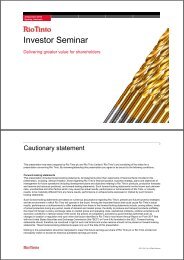


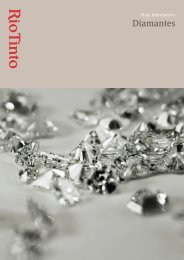

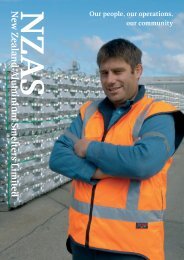
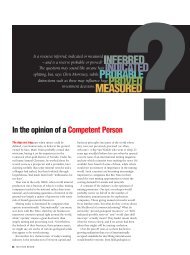
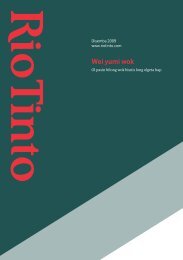
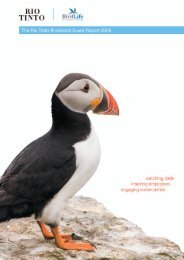
![Download pdf file [PDF: 1.26 MB] - Rio Tinto](https://img.yumpu.com/10319684/1/190x253/download-pdf-file-pdf-126-mb-rio-tinto.jpg?quality=85)
